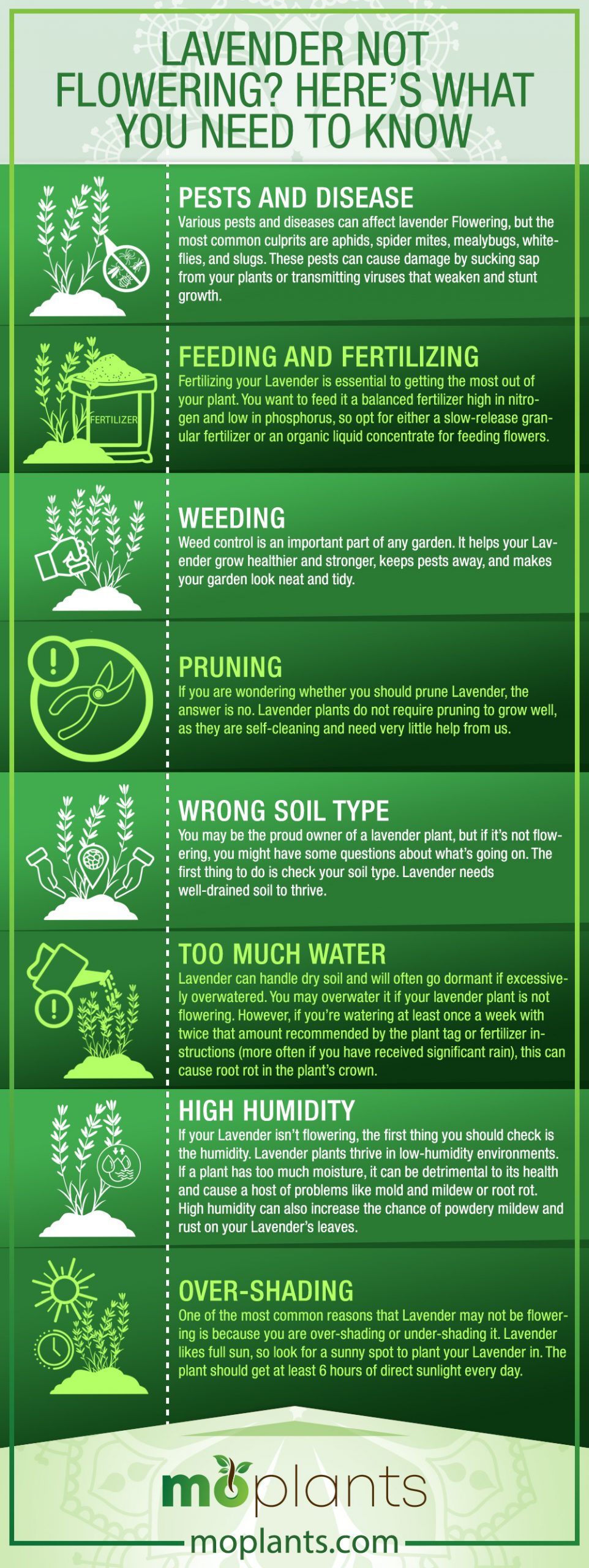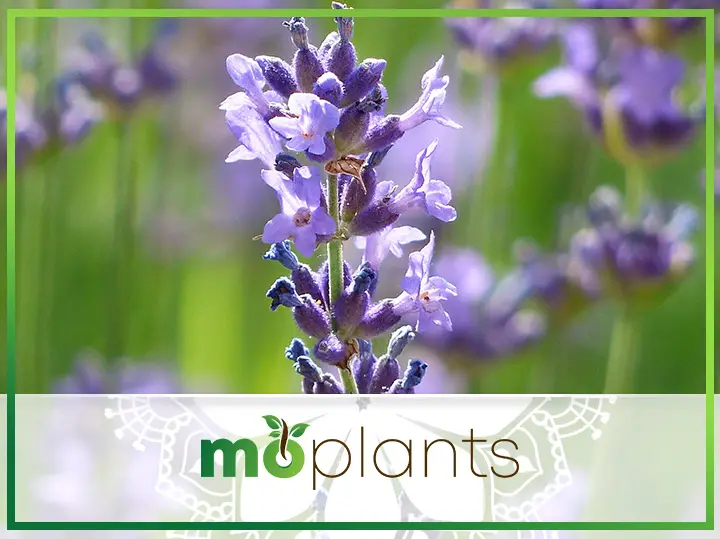Lavender is a beautiful, fragrant, and versatile plant. It’s easy to grow indoors or out, making it one of the most popular herbaceous perennials on the market. But if your Lavender isn’t flowering, don’t worry. There are plenty of reasons why this could be happening. Read on to find out why your Lavender may not be flowering and what you can do about it:
Pests and Disease
Various pests and diseases can affect lavender Flowering, but the most common culprits are aphids, spider mites, mealybugs, whiteflies, and slugs. These pests can cause damage by sucking sap from your plants or transmitting viruses that weaken and stunt growth.
If you have an infestation of pest or disease on your lavender flower heads, it’s essential to act quickly before they spread further into the plant. If you notice any signs of trouble on one flower head, check all nearby flower heads. These pests are notorious for spreading quickly through a plant.
Powdery mildew is one of the most common diseases affecting lavender flowers, although it doesn’t usually kill a plant if treated early enough. However, rust (Phragmidium violaceus) can be devastating for some varieties, so always treat this immediately if found on your Lavandula angustifolia cultivar hybrids.
Feeding and Fertilizing
Fertilizing your Lavender is essential to getting the most out of your plant. You want to feed it a balanced fertilizer high in nitrogen and low in phosphorus, so opt for either a slow-release granular fertilizer or an organic liquid concentrate for feeding flowers.
You should fertilize your Lavender every two weeks during the spring and summer months at half the recommended strength. If you’re unsure about how much fertilizer to apply, start with 1/4 teaspoon per plant and work up from there. This way, you can figure out what amount works best for your soil type and climate zone before going overboard.
Weeding
Weed control is an important part of any garden. It helps your Lavender grow healthier and stronger, keeps pests away, and makes your garden look neat and tidy.
What you should do:
1 – Once a week or so, pull up the growing weeds between the plants with your hands (or a pair of gardening gloves). You can also use a spade or hoe to dig up some of the bigger ones if they’re too big for you to pull out by hand.
2 – If something is growing between two plants that aren’t supposed to be there (like grass), use scissors or pruning shears to cut off those parts from around them before they become too large.
3 – If young seedlings are growing where you don’t want them, pull them out as soon as possible before they have enough time to spread their roots into other parts of your lavender bedding display.
Pruning
If you are wondering whether you should prune Lavender, the answer is no. Lavender plants do not require pruning to grow well, as they are self-cleaning and need very little help from us.
However, if your Lavender has died back or become overgrown and leggy, you may consider cutting it down to size (and possibly removing some of the dead wood).
Wrong Soil Type
You may be the proud owner of a lavender plant, but if it’s not flowering, you might have some questions about what’s going on. The first thing to do is check your soil type. Lavender needs well-drained soil to thrive.
If the soil around your plant is soggy or waterlogged for too long, it will become rootbound and ultimately die off. To grow healthy plants that produce plenty of flowers, aim for a pH between 6 and 7 (slightly acidic).
Lavender prefers sandy or loamy soils that drain well. If your soil has too much clay, dig in some perlite or sand to lighten things up while maintaining good drainage.
Too Much Water
Lavender can handle dry soil and will often go dormant if excessively overwatered. You may overwater it if your lavender plant is not flowering. However, if you’re watering at least once a week with twice that amount recommended by the plant tag or fertilizer instructions (more often if you have received significant rain), this can cause root rot in the plant’s crown.
Too much water also makes your Lavender grow too large and become leggy. This leads to long stems between the leaves instead of short ones, making it harder for flowers to form on top of long stems instead of closer together on shorter ones, as nature intended.
High Humidity
If your Lavender isn’t flowering, the first thing you should check is the humidity. Lavender plants thrive in low-humidity environments. If a plant has too much moisture, it can be detrimental to its health and cause a host of problems like mold and mildew or root rot. High humidity can also increase the chance of powdery mildew and rust on your Lavender’s leaves.
If you have noticed that your Lavender has been getting brown spots on its leaves or stems, this could be due to drying out too much after watering it or not enough water during hot weather months when temperatures rise above 80 degrees Fahrenheit (26 Celsius). In addition, overwatering may also cause brown spots on leaf tips, while underwatering will cause wilting tips instead.
Over-shading
One of the most common reasons that Lavender may not be flowering is because you are over-shading or under-shading it. Lavender likes full sun, so look for a sunny spot to plant your Lavender in. The plant should get at least 6 hours of direct sunlight every day.
It does not tolerate shady areas very well and will likely not flower if it gets less than 6 hours of daily direct sunlight. You can also test this by placing a small stone on the soil next to your plant. If you see new growth within 2 weeks, your plant has enough light to grow and flower properly.
If your Lavender does not like shade, move it to a sunnier location. If they don’t grow after trying several different locations in full sun with 6+ hours of light each day, then add another inch or two height underneath where they are now growing. This might give them more room, so they’ll be happier there longer without moving them elsewhere again.
Infographic

Not all Lavender Varieties Produce Flowers at the Same Time
Lavender is a perennial plant that produces beautiful purple flowers. The variety you buy at your local nursery will likely be a flowering version of the plant, meaning it will flower one or more times each year.
However, not all lavender varieties produce flowers at the same time. Some types can flower as early as June, and others may not begin flowering until late August or September. Some types even have multiple flushes of blossoms during a single season.
If you’re looking for lavender bushes with bright purple blooms throughout your garden’s growing season, then look no further than these five Lavandula angustifolia varieties:
- ‘Blue Hill’ – This variety begins flowering around mid-June and continues into July before entering its dormant period from late summer through autumn.*
- ‘Blue Pyramidalis’ – Lavender produces large clusters of soft blue-purple buds atop tall stems.
- ‘Celestial Blue’ – While this variety doesn’t produce quite as many blossoms as other types, they are large and numerous enough to make up for it.
- ‘Hidcote’ (a hybrid between L. Angustifolia x L. latifolia) – This cultivar blooms twice yearly, with multiple flushes occurring between May and September.
- ‘Lady’s Mantle’ – This cultivar has deep purple flowers which appear sporadically throughout the growing season, starting in early summer and right through fall.
Transplant Shock can Reduce Flowering.
The new environment you plant your Lavender in may be different from the last one, which can cause it to experience a stress response. This stress response can result in a change of color, growth reduction, and even flower loss.
It’s often recommended that you water your Lavender regularly until it is established in its new location to acclimate more efficiently and avoid transplant shock.
If you have a transplant shock and your Lavender is not flowering well:
- Wait for one more year before assessing whether or not this is an ongoing problem. Transplanting plants from one growing environment to another can cause some issues initially; however, these should resolve themselves over time as the plant adjusts to its new surroundings. If, after two years (or less), there are still no flowers on your Lavender, then it might be time for action.
- Ensure adequate sunlight exposure by moving the container closer to where they will receive direct light during the day and providing artificial lighting at night if necessary (the latter being especially true if there are no windows within proximity). Lavenders do best when exposed directly overhead by natural light for several hours daily. However, since this isn’t always possible outdoors due to lack thereof or limited indoor access, supplemental lighting will suffice just fine until better conditions arise.”
Don’t Worry. Lavender Will Come Back.
If you’re thinking about starting over with another lavender plant, don’t worry – it won’t take long for your new flowers to sprout. Lavender is quite hardy, and though your Lavender may not look like what it did before for a few years, it will come back.
Since each plant is different (and some varieties are slower to grow than others), there’s no way of knowing how long it might take to flower again. If you want lavender blooms in the springtime again next year, start over with a new plant.
As far as advice goes, keep both plants in pots instead of burying them in the ground so they can be moved around as needed. Also, ensure that all parts of the plant are kept moist throughout this process so that growth resumes quickly once warmer weather arrives.
Conclusion
We hope we’ve helped you understand why your Lavender isn’t flowering. The key takeaway is to not give up on your Lavender. It may take some experimentation with soil types, watering habits, or fertilizer programs before the plant blooms again. Still, these problems can be overcome by careful planning and knowledge about what’s going on inside your garden. Don’t forget: even if it takes a few years for your plants to start flowering again, they will come back stronger than ever once they do start blooming again.

